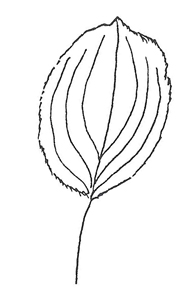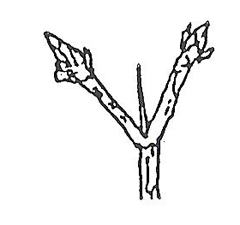Rhamnus cathartica (ram’-nus ka-thar’-ti-ka)
Family: Rhamnaceae, Buckthorn
Key Steps
- 1a – Opposite leaf arrangement on stem — go to 2
- 2a – Leaf simple — go to 3
- 3b Leaves are unlobed — go to 11
- 11b – Leaf margins finely serrated — go to 12
- 3b Leaves are unlobed — go to 11
- 2a – Leaf simple — go to 3
Description
 Leaf: Usually sub-opposite, a few leaves may be alternate. Fine-toothed margin. Hairless. 3 inches long by 1 1/2 inches wide. Round to oval, broadest at or above middle. Smooth, rounded or obtuse base, with sharp point at tip. Dark green above, paler below. 3-5 pairs of veins that start at the center vein (midrib) and curve following leaf margin.
Leaf: Usually sub-opposite, a few leaves may be alternate. Fine-toothed margin. Hairless. 3 inches long by 1 1/2 inches wide. Round to oval, broadest at or above middle. Smooth, rounded or obtuse base, with sharp point at tip. Dark green above, paler below. 3-5 pairs of veins that start at the center vein (midrib) and curve following leaf margin.
Bud: May be pressed against stem, brownish-black, 1/4 inch long. Several scales.
Leaf Scar: 1 to 3 bundle scars. No connecting line between leaf scars.
Stem: Dark, unlined, slender, pale reddish-brown to brownish-black. Short stems bear flowers and tufted foliage. Yellow inner bark. Narrow, vertical lenticels. Stems usually ends in a sharp spine about as long as the bud.

Bark: Gray-brown, rough-textured, similar to plum tree.
Pith: Pale brown, solid.
Flower: Small, greenish, axillary clusters, 2-5 flowers, after leaves. Flower parts in 4s. Plants are dioecious (male and female plants).
Fruit: Dark, berry-like drupe, shiny, 3-4 bony nutlets. Single or clustered. Fruit not edible.
Habit: Large, open shrub or small tree, 8 to 15 feet tall in our area. Spreading branches.
Culture: Adaptable once established. Rather invasive.
Note: Considered a noxious weed in Eastern U.S. and Canada
Resources




